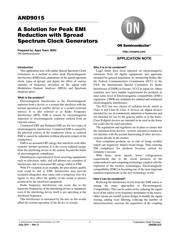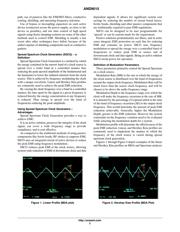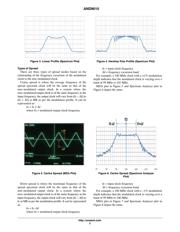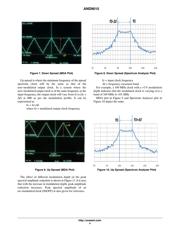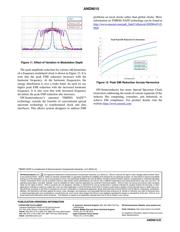下载

© Semiconductor Components Industries, LLC, 2011
July, 2011 − Rev. 0
1 Publication Order Number:
AND9015/D
AND9015
A Solution for Peak EMI
Reduction with Spread
Spectrum Clock Generators
Prepared by: Apps Team, BIDC
ON Semiconductor
Introduction
This application note will outline Spread Spectrum Clock
Generators as a method to solve peak Electromagnetic
Interference (EMI) issue, parameters of the spread spectrum
clock, types of spread, and depict the effect of various
amounts of frequency deviation on the signal with
Modulation Domain Analyzer (MDA) and Spectrum
Analyzer plots.
What is the problem?
Electromagnetic Interference is the Electromagnetic
emission from a device or a system that interferes with the
normal operation of another device or a system (external
source). It is also referred to as Radio Frequency
Interference (RFI). EMI is caused by electromagnetic
induction or electromagnetic radiation emitted from an
external source.
Conducted EMI and Radiated EMI are the two types of
electromagnetic interference. Conducted EMI is caused by
the physical contact of the conductors where as radiated
EMI is caused by induction (without physical contact of the
conductors).
EMI is an unwanted RF energy that interferes with other
systems’ normal operation. It is the excess radiated energy
from the interfering device or the system, beyond the limits
of electromagnetic compliance.
Disturbances experienced in local receiving equipments
such as television, radio, and cell phones are examples of
interference due to unwanted RF energy which is EMI.
With TV reception as an example, the poor picture quality
seen could be due to EMI. Interference may prevent
reception altogether, may cause only a temporary loss of a
signal, or may affect the quality of the sound or picture
produced by the interfered equipment.
Radio frequency interference can occur due to the
harmonic frequencies of the interfering device or equipment
even if the interfering device itself is not operating at the
interfered frequency.
This interference is unwanted by the user as this would
affect the normal operation of the device or system.
Why it is to be contained?
Legal limits have been imposed on electromagnetic
emissions from all digital equipments and apparatus
intended for general population, by monitoring bodies like
the Federal Communication Commission (FCC) in the
USA, the International Special Committee for Radio
Interference (CISPR) in Europe, VCCI in Japan etc. Many
countries now have similar requirements for products to
meet some level of Electromagnetic compatibility (EMC)
regulation. CISPR sets standards for radiated and conducted
electromagnetic interference.
The FCC has two classes of radiation levels, stated as
Class A and Class B. Class A devices are digital devices
intended for use in commercial, industrial or businesses and
not intended for use by the general public or in the home.
Class B digital devices are intended to be used in the home
but could also be used elsewhere.
The regulations and regulators are in place to ensure that
the emissions from devices / systems released to market do
not interfere with the normal functioning of other devices /
systems already in the market.
Non−compliant products are at risk of being recalled
which can negatively impact brand image. Thus ensuring
EM compliance for products becomes critical for
company’s success.
With faster clock speeds, lower voltage/power
requirements due to the recent advances in the
semiconductor and computing technology coupled with the
explosion of the wireless technologies, Electromagnetic
compatibility (EMC) is becoming one of the most important
standard requirements in the new technology world.
How it can be contained?
Reducing the interference levels from the EMI source is
among the many approaches to Electromagnetic
Compatibility. This can be achieved by reducing the signal
level of the source or by frequency modulation at the source.
Other means are careful system design, to modify the signal
routing, adding local filtering, reducing the number of
interconnections, increase the separation of the coupling
http://onsemi.com
APPLICATION NOTE

